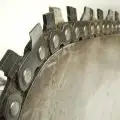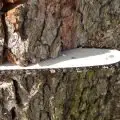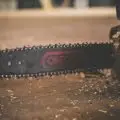They go by many names: dog teeth, bucking spikes, bumper spikes, felling dogs, dawgs, you name it. Whatever you choose to name them, they are the spikes that may be found at the back of a chainsaw.
For some, these dogs are a nuisance and should be removed immediately. Others see them as a useful tool to aid in woodworking, but are chainsaw dog teeth absolutely necessary?
While felling dogs are an optional feature on a chainsaw, they offer the chainsaw user a great deal of stability and leverage by providing an anchor point for the saw at the back of the bar.
This is very useful when working with larger diameter logs or cutting constantly for lengthy periods of time, such as while cutting firewood. They do, however, have a few drawbacks.
In this article, we’ll discuss everything you need to know about felling dogs, including what they’re used for, the different types, and the advantages vs. disadvantages of using them.
Table of Contents
- What Felling Dogs Are Used For?
- Felling Dogs Advantages vs Disadvantages
- Types of Felling Dogs
- Single vs Dual Felling Dogs?
- FAQs (Frequently Asked Questions)
What Felling Dogs Are Used For?
We may take chainsaws for granted, yet they are tremendously powerful equipment with enormous energy output. Controlling this energy can be challenging, especially when it is large.
As the saw’s motor speeds up, momentum forces the bar to rise, and if the chainsaw’s tip strikes something, it might generate a kickback. This is when the felling dogs come into play.
Felling dogs allow the sawyer to secure the chainsaw into the tree or log itself, providing for greater control and precision in a cut. The chainsaw can be levered using the felling dogs as an anchored fulcrum, allowing the sawyer to cut more aggressively without putting too much strain on the saw itself.
Felling dogs provide an additional level of safety for the operator by reducing the possibility of chainsaw kickbacks or uncontrolled results. Of course, even with dogs, operators need far more safety equipment.
Felling Dogs Advantages vs Disadvantages
Advantages
There are two instances in which felling dogs with a chainsaw is very advantageous:
- Large diameter logs are felled and bucked.
- Bucking firewood is an example of a continuous chopping activity.
The advantage of felling dogs for greater diameter logs is obvious. As the diameter of the log increases, the pressure applied to the saw by the sawyer is dispersed across a broader area, lowering the pressure per square inch.
When combined with the natural rising of a chainsaw in motion, this can significantly slow down cuts and exhaust the operator by requiring more pressure to force the saw to cut.
By securing the saw with felling dogs and utilizing it as a fulcrum to lever the saw, the operator can apply pressure more consistently and effortlessly, allowing the saw to accomplish the majority of the job.
Similarly, the same idea can be utilized to significantly reduce total workload and tiredness from jobs that need continuous cutting, such as firewood chopping. Fatigue builds up with time. Even if the logs are little, cutting a thousand times will take its toll, so make every cut as simple as possible.
The sawyer can cut through an entire cord of wood like butter by using the bottom of the felling dogs to bear into the log and lever the chainsaw bar length through the cut. It makes cutting firewood and bucking logs a breeze, which is why these teeth are sometimes referred to as “bucking spikes.”
Disadvantages
Felling dogs has two major disadvantages:
- The bar length is now shorter.
- More room for small sticks and brush to be caught.
Equipping your chainsaw with felling dogs reduces the length of the cutting bar significantly, but this can be mitigated by utilizing the right size teeth, which we shall explain later. However, in comparison to the benefits of the dogs, this is mostly a minor annoyance.
The most significant disadvantage of using felling dogs is that it creates a space in which small, loose branches and brush might become entangled when the chain draws the material toward the dogs.
If you perform a lot of yard work with saws, this is an important concern, which is why many smaller household chainsaws come without felling dogs.
It’s also something to think about if you operate with a lot of tiny stuff, like chopping up slab wood for firewood. Consider these drawbacks while deciding whether or not to utilize them.
Types of Felling Dogs
Felling dogs bumper spikes are classified into two types: those with little teeth and those with larger, more aggressive teeth. Which type to utilize is primarily determined by what you intend to cut.
Larger teeth are typically seen on larger trees with thicker, softer bark, such as cedars and pines. The saw’s large teeth allow it to burrow into the bark and cut without slipping. They can also provide the sawyer slightly more leverage over the cut by sticking out wider, which can aid with larger logs.
Smaller teeth, on the other hand, are better suited to smaller trees as well as those with thinner, stronger bark. Larger dogs will simply not benefit if the bark on the tree is thin and/or difficult to penetrate, therefore shorter teeth are preferable to keep more of the bar exposed and useable.
Pro safety felling dogs, no matter how long their teeth are, will be unable to grip this spruce for more than a quarter of an inch.
When selecting what size felling dogs to utilize, bar length should also be considered. As previously stated, felling dogs have the disadvantage of reducing bar length. Longer teeth will cover a larger portion of the bar.
As a result, if you intend to utilize larger teeth, a chainsaw bar 20′′ or longer is recommended; otherwise, too much of the bar will be covered. Shorter bars work better with shorter teeth.
Learn more about chainsaw bar length in the following guides:
- How to Measure a Chainsaw Bar & Chain Length the RIGHT way
- Are Chainsaw Bars Interchangeable?
- Can I Put a Shorter Bar on My Chainsaw?
- Can I Put a Longer Bar on My Chainsaw?
Single vs Dual Felling Dogs?
A dual-felling dog setup on a chainsaw (one on each side of the bar) will surely improve the sawyer’s grip and control. However, not all chainsaws are built to accommodate two dogs.
If the manufacturer did not intend for the chainsaw to be equipped with two dogs, it will be impossible to do so without extensive modification to the single felling dog. It is important to consult the user handbook for your chainsaw to discover what is compatible with your model.
Here are a couple of YouTube examples of felling dogs for Stihl chainsaws:
FAQs (Frequently Asked Questions)
What are felling dogs made of?
These large falling or felling dogs are composed of tough 1/8″ thick heat-treated steel. Without the bending or wobbling of stock dogs, they make ratcheting into position much easier.
What are the spikes on a chainsaw for?
They are also known as felling spikes, and they are useful when cutting the notch and back cut when felling. I can’t picture attempting to muscle a 24″ bar horizontally while felling without the spikes.
What is a felling dog?
They are also known as felling spikes, and they are useful when cutting the notch and back cut when felling. I can’t picture attempting to muscle a 24″ bar horizontally while felling without the spikes.






